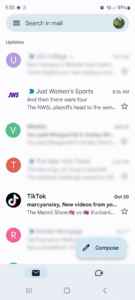All Hail Email Marketing: June 12-18 is National Email Week
It’s Email Marketing Week! And at CloudControlMedia we love email – we love to use it to connect our team, communicate with our partners, market on behalf of our clients, and reach new customers. And we especially love the high ROI on our email marketing efforts, both for our clients and ourselves. So, to celebrate this week, we want to take a look at the importance and history of this valuable digital tool.
A Little Email History Lesson
Did you know email marketing is one of the oldest and greatest digital marketing mediums? Email can be traced back to the 1970s. The very first newsletter, Electronic Mail and Message Systems (EMMS), was launched in December of 1977 using Advanced Research Projects Agency Network (ARPANET) – a precursor to the Internet as we know it today. The following year, the first mass marketing email was sent by Gary Thurek; he asserts to have gained $13 million in sales from that email. Thurek was also later crowed, “The Father of Spam.”
While Thurek didn’t exactly use a permission-based email strategy when he messaged hundreds of unsuspecting ARPANET users, we now know he was onto something big. However, it would be more than a decade before the term Digital Marketing would gain wide use and email marketing would rocket to the forefront of business.
During the 1990s, more households gained access to the internet – and their own email accounts – sparking digital marketing’s arrival into our everyday lives. The decade that brought us grunge and hip-hop also gave birth to AOL’s “You’ve Got Mail” and the emergence of webmail services like Hotmail and Yahoo. By 1999 over 400 million people jumped online.
Marketers quickly realized that sending an email to hundreds of thousands of people was exponentially cheaper than paying for printing and postage of direct mail campaigns. Unfortunately, this ease of use quickly led to some marketers abusing the power of digital marketing and the term spam was officially introduced into the New Oxford dictionary in 1998.
In the following 25 years several laws have been established to help keep bad actors in line and allow for the continued growth of email marketing. The most famous American legislation is the Controlling the Assault of Non-Solicited Pornography And Marketing Act, or CAN-SPAM Act, that was signed into law in 2003. If you’re a seasoned digital marketer, you know the basics of this law, which sets rules for commercial email including opt-out regulations and transparent identity information like requiring a physical address in emails.
Technology continues to evolve, and more privacy concerns rise, which means email marketing and digital marketing as a whole will continue to advance including laws and regulations. As a digital marketer it’s important to understand the rules that surround running an email marketing campaign so you can fully realize the value.
The Power of Email
A lot has changed in the digital landscape in the last 45 years since Thuerk sent his mass mailing. Thuerk’s simple text only message inviting recipients to participate in a product demo achieved a 10% conversion rate and, as previously mentioned, an approximate $13 million return on his very small investment!
While achieving that level of ROI might be a tall order, research shows that email marketing today boasts an average of $38 earned on every dollar spent. In comparison, SEO efforts report having a 22 to 1 ROI while pay-per-click advertising is 2 to 1. With numbers like that, why wouldn’t you jump into the email world? After all, it’s what people want.
More than half of the world’s population is on email and most – 55% – prefer to receive information in their inboxes. And they engage with it! On average email marketing campaigns have an open rate of more than 21%, with some industries as high as 27%, and a click-through-rate (CTR) of 2.6%. Some industries report average CTRs over 5%. Depending on the type of campaign and the segmentation and personalization implemented, you have the potential to blow these average statistics out of the water.
At CloudControlMedia, with the right messaging, triggered at the right time, we’ve successfully gained open rates of 70% and CTRs as high as 17%. While admittedly these impressive results may not be the norm for every campaign, the potential for gains for any business, school, or organization exist. Email isn’t going away. In fact, projections show a 13% increase in email marketing revenue in the coming years with a forecasted value of $17.9 billion by 2027!
If you’re ready to make the most out of your email marketing campaigns, reach out to the experts at CloudControlMedia for help.
Marcy Ansley, Director of Email and Social Engagement







